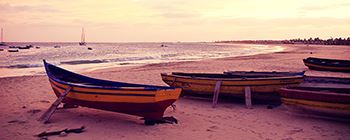
Landscapes of Salt
When arriving…
The island was discovered in 1460 by the Genovese Antonio di Noli, at the service of Infante D. Henrique and the Portuguese sea expansion. The beauty and the waves of Sal’s beaches could not pass unnoticed. Today this is a must-wanted destination for those who practise windsurf and scuba diving, but also tourists just looking for the sweet calmness of cape verdean hospitality.
This kind of friendliness is noticed everywhere: they call it “morabeza”, a feeling that represents the people of Cape Verde the same way “saudade” ("longing") characterizes the Portuguese soul. It's a feeling hard to translate or even to explain, only perceived on the kindness and the local carefree lifestyle.

The scenery of the island is very specific, combining white sand beaches open arid landscapes without a sight of vegetation. These particular geographic features are determined by African winds that bring the sand from the Sahara desert. But the proximity to that region doesn't necessarily mean unbearable weather conditions: temperatures fluctuate between at least 24ºC and maximum 30ºC in the Summer. Pretty much perfect, right?
After landing at Espargo’s airport — the capital located on the west coast of the central part of the island – get ready to venture into a land with an untouched pureness. Sal is only 30 km long and 12 km wide; one hospital, one fire station, one cultural centre, one library!
At the centre
You can start by relaxing at Palmeiras beach. Beginning on the white sand beaches of this village, you can — but definitely must — go for a swim on the saline’s that gave the name to the island. And you can watch them close in places such the picturesque village of Pedra de Lume, on the east coast. All of the equipment’s used in salt production are in the same place where they were left since 1980, as a living proof of the glorious age of the salt exploration in the island.


Up north
Continue to explore calmly into the north coast, where you will find the Fiúra lighthouse. Near by you'll find the Buracona cape, very well known for its captivating natural swimming pools. After you get a fresh swim on this oasis, take a few moments to explore the volcanic rocks around. But we must warn you: take the robust boots with you so you'll be able to walk as much (and where) you want.
Going south
Once you've arrived to the south side of the island, you have many options to stay in on the hotels and the establishments of Santa Maria. This is the main centre of touristic attraction in Sal, both for its extensive white-sanded beaches and for the amazing local foods and handcraft. In addition to that, there are lots of local activities for you to explore, such as fishing, diving and the observation of sharks and turtles.
If you want to learn the traditional dances and sounds such as funaná and morna, you definitely have to mix with the locals. Wherever you are — a bar, a restaurant or simply in the middle of the street, “morabeza” will follow you.
So set up your biological clock into cape verdean time zone and let yourself go with the African rhythm. Just like a little peace of heaven, far far away from the crowds.


